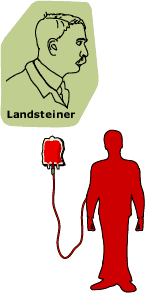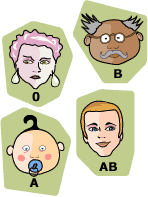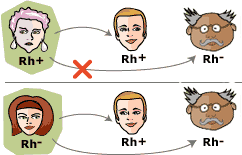How Do We Get the Red and White Phenotypes Again?

Blood Groups, Blood Typing and Blood Transfusions
The discovery of blood groups
Experiments with claret transfusions, the transfer of blood or blood components into a person'southward blood stream, take been carried out for hundreds of years. Many patients have died and information technology was not until 1901, when the Austrian Karl Landsteiner discovered human blood groups, that claret transfusions became safer.
Mixing blood from ii individuals can atomic number 82 to claret clumping or agglutination. The clumped cherry cells tin can crack and cause toxic reactions. This can have fatal consequences. Karl Landsteiner discovered that blood clumping was an immunological reaction which occurs when the receiver of a blood transfusion has antibodies confronting the donor blood cells.
Karl Landsteiner's work made it possible to determine blood groups and thus paved the way for blood transfusions to be carried out safely. For this discovery he was awarded the Nobel Prize in Physiology or Medicine in 1930.
What is claret made up of?
An adult man has about iv–vi liters of blood circulating in the torso. Among other things, claret transports oxygen to diverse parts of the body.
Blood consists of several types of cells floating around in a fluid called plasma.
The ruby-red blood cells incorporate hemoglobin, a protein that binds oxygen. Red blood cells transport oxygen to, and remove carbon dioxide from, the body tissues.
 The white blood cells fight infection.
The white blood cells fight infection.
The platelets help the blood to clot, if you get a wound for example.
The plasma contains salts and diverse kinds of proteins.
What are the different blood groups?
 The differences in human blood are due to the presence or absence of certain protein molecules called antigens and antibodies. The antigens are located on the surface of the ruby blood cells and the antibodies are in the blood plasma. Individuals have different types and combinations of these molecules. The blood group you belong to depends on what you take inherited from your parents.
The differences in human blood are due to the presence or absence of certain protein molecules called antigens and antibodies. The antigens are located on the surface of the ruby blood cells and the antibodies are in the blood plasma. Individuals have different types and combinations of these molecules. The blood group you belong to depends on what you take inherited from your parents.
There are more than xx genetically determined blood group systems known today, but the AB0 and Rh systems are the almost important ones used for blood transfusions. Not all claret groups are uniform with each other. Mixing incompatible blood groups leads to blood clumping or agglutination, which is unsafe for individuals.
Nobel Laureate Karl Landsteiner was involved in the discovery of both the AB0 blood group (in 1901) and Rh claret group (in 1937).
AB0 blood group system
According to the AB0 blood group system in that location are four different kinds of blood groups: A, B, AB or 0 (null).
Rh factor blood grouping system
 Many people also have a so called Rh gene on the red blood prison cell's surface. This is also an antigen and those who take it are chosen Rh+. Those who haven't are called Rh-. A person with Rh- blood does not have Rh antibodies naturally in the claret plasma (equally one tin accept A or B antibodies, for instance). Only a person with Rh- blood can develop Rh antibodies in the blood plasma if he or she receives blood from a person with Rh+ blood, whose Rh antigens can trigger the product of Rh antibodies. A person with Rh+ blood can receive blood from a person with Rh- blood without any issues.
Many people also have a so called Rh gene on the red blood prison cell's surface. This is also an antigen and those who take it are chosen Rh+. Those who haven't are called Rh-. A person with Rh- blood does not have Rh antibodies naturally in the claret plasma (equally one tin accept A or B antibodies, for instance). Only a person with Rh- blood can develop Rh antibodies in the blood plasma if he or she receives blood from a person with Rh+ blood, whose Rh antigens can trigger the product of Rh antibodies. A person with Rh+ blood can receive blood from a person with Rh- blood without any issues.
Blood group annotation
According to above blood grouping systems, you tin can belong to either of following 8 blood groups:
| A Rh+ | B Rh+ | AB Rh+ | 0 Rh+ |
| A Rh- | B Rh- | AB Rh- | 0 Rh- |
Do y'all know which claret grouping you lot vest to?
Blood typing – how do y'all find out to which blood group someone belongs?
one.
Y'all mix the blood with three different reagents including either of the iii different antibodies, A, B or Rh antibodies.
2.
Then you take a wait at what has happened. In which mixtures has agglutination occurred? The agglutination indicates that the blood has reacted with a certain antibody and therefore is not compatible with blood containing that kind of antibody. If the claret does non agglutinate, it indicates that the blood does not have the antigens bounden the special antibody in the reagent.
3.
If you know which antigens are in the person's blood, it'due south like shooting fish in a barrel to figure out which blood group he or she belongs to!
| A person with A+ blood receives B+ blood. The B antibodies (yellow) in the A+ claret attack the foreign red blood cells by binding to them. The B antibodies in the A+ blood bind the antigens in the B+ blood and agglutination occurs. This is unsafe because the agglutinated red blood cells break after a while and their contents leak out and become toxic. |
What happens when blood clumps or agglutinates?
For a blood transfusion to exist successful, AB0 and Rh blood groups must be compatible between the donor claret and the patient blood. If they are not, the cherry-red blood cells from the donated blood volition clump or agglutinate. The agglutinated ruddy cells can clog blood vessels and finish the apportionment of the blood to various parts of the body. The agglutinated ruby claret cells as well crack and its contents leak out in the body. The red blood cells contain hemoglobin which becomes toxic when outside the jail cell. This tin have fatal consequences for the patient.
The A antigen and the A antibodies can bind to each other in the same way that the B antigens can bind to the B antibodies. This is what would happen if, for example, a B claret person receives claret from an A blood person. The reddish blood cells will be linked together, like bunches of grapes, by the antibodies. As mentioned earlier, this clumping could lead to death.
Claret transfusions – who can receive blood from whom?
Of grade you lot can always requite A blood to persons with claret grouping A, B blood to a person with claret group B and so on. Only in some cases you can receive blood with another type of claret group, or donate blood to a person with some other kind of blood group.
The transfusion will piece of work if a person who is going to receive blood has a blood grouping that doesn't have any antibodies against the donor blood's antigens. But if a person who is going to receive blood has antibodies matching the donor blood'southward antigens, the red blood cells in the donated blood volition clump.
 | People with claret group 0 Rh - are called "universal donors" and people with blood group AB Rh + are called "universal receivers." Rh + blood can never be given to someone with Rh - claret, merely the other way effectually works. For example, 0 Rh + blood can not exist given to someone with the blood type AB Rh - . |
| Blood Group | Antigens | Antibodies | Can give blood to | Can receive blood from |
| AB Rh + | A, B and Rh | None | AB Rh + | AB Rh + AB Rh - A Rh + A Rh - B Rh + B Rh - 0 Rh + 0 Rh - |
| AB Rh - | A and B | None (Can develop Rh antibodies) | AB Rh - AB Rh + | AB Rh - |
| A Rh + | A and Rh | B | A Rh + AB Rh + | A Rh + A Rh - 0 Rh + 0 Rh - |
| A Rh - | A | B (Tin can develop Rh antibodies) | A Rh - A Rh + AB Rh - AB Rh + | A Rh - 0 Rh - |
| B Rh + | B and Rh | A | B Rh + AB Rh + | B Rh + B Rh - 0 Rh + 0 Rh- |
| B Rh - | B | A (Can develop Rh antibodies) | B Rh - B Rh + AB Rh - AB Rh + | B Rh - 0 Rh - |
| 0 Rh + | Rh | A and B | 0 Rh + A Rh + B Rh + AB Rh + | 0 Rh + 0 Rh - |
| 0 Rh - | None | A and B (Can develop Rh antibodies) | AB Rh + AB Rh - A Rh + A Rh - B Rh + B Rh - 0 Rh + 0 Rh - | 0 Rh - |
Starting time published 3 December 2001
To cite this folio
MLA manner: "Blood Groups, Claret Typing and Blood Transfusions". Nobelprize.org. Nobel Prize Outreach AB 2021. Web. 19 Mar 2022. <http://educationalgames.nobelprize.org/educational/medicine/landsteiner/readmore.html>
Source: https://educationalgames.nobelprize.org/educational/medicine/landsteiner/readmore.html
Posting Komentar untuk "How Do We Get the Red and White Phenotypes Again?"